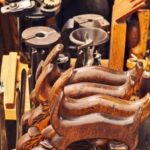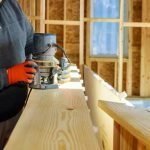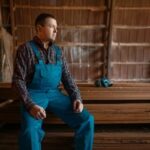Are you struggling with stubborn hairspray build-up on your woodwork? In this article, we will explore the damaging effects of hairspray on wood surfaces, the importance of promptly removing hairspray residue, and effective DIY methods for safely and effectively cleaning hairspray from wood surfaces. Whether you’re dealing with a light residue or stubborn stains, we’ve got you covered with natural solutions, household products, and professional cleaning techniques to tackle the dilemma of hairspray build-up on woodwork.
Hairspray is a common culprit for leaving behind a sticky residue on wood surfaces, creating an unsightly and difficult-to-remove build-up. Understanding the damaging effects of hairspray on wood surfaces is essential in order to prevent long-term damage and maintain the beauty of your woodwork. From discoloration to sticky residues, the effects of hairspray can diminish the appearance and quality of your wood furniture and fixtures.
Promptly removing hairspray residue from woodwork is crucial to prevent any further damage and preserve the integrity of your wood surfaces. Ignoring or neglecting the build-up can lead to more difficult cleaning processes and potentially irreversible damage. In the next sections, we will explore various methods for effectively removing hairspray from wood surfaces, ensuring that your furniture and fixtures remain clean and well-maintained.
Understanding the Damaging Effects of Hairspray on Wood Surfaces
When hairspray is used in close proximity to wood surfaces, it can lead to a build-up of residue that can be difficult to remove. Hairspray contains various chemicals and substances that, when left unattended for prolonged periods, can cause significant damage to woodwork. The sticky nature of hairspray residue can attract dust and dirt, leading to discoloration and an unsightly appearance on wood surfaces.
Furthermore, the alcohol content in hairspray has the potential to dissolve the finish on woodwork, causing it to become dull and discolored over time. Additionally, the residue left behind by hairspray can attract insects and pests, leading to further deterioration of the wood surface.
Understanding the damaging effects of hairspray on wood surfaces is essential in order to effectively remove it and prevent long-term damage. Whether your woodwork is finished with paint or varnish, it is important to address any hairspray residue promptly in order to avoid irreversible harm.
To avoid these damaging effects of hairspray on wood surfaces, it is crucial to effectively remove any build-up before it becomes a larger issue. Below are some DIY methods for safely removing hairspray from wood surfaces:
- Wipe down the affected areas with a soft cloth dampened with warm soapy water.
- Use a mixture of vinegar and water for a natural solution that effectively removes hairspray residue from wood surfaces.
- Apply mayonnaise or petroleum jelly directly onto the affected area and let sit for several minutes before wiping clean.
By taking immediate action using the appropriate cleaning methods, you can prevent long-term damage caused by hairspray build-up on your woodwork.
The Importance of Promptly Removing Hairspray Residue From Woodwork
Woodwork such as wooden furniture, cabinets, and trim can often fall victim to the sticky residue left behind by hairspray. While hairspray may be great for keeping hairstyles in place, it can wreak havoc on wood surfaces if not promptly dealt with. This section will discuss the importance of promptly removing hairspray residue from woodwork and offer some effective DIY methods for doing so.
When hairspray builds up on wood surfaces, it can cause discoloration, stickiness, and even damage to the finish. Over time, this build-up can become increasingly difficult to remove, making it essential to address the issue as soon as possible. Not only does prompt removal prevent unsightly residue from accumulating, but it also helps to preserve the integrity of the woodwork.
One effective DIY method for removing hairspray from woodwork involves using a mixture of warm water and mild dish soap. By gently scrubbing the affected area with a soft cloth dampened with this solution, you can often lift away hairspray residue without causing harm to the wood surface. For stubborn build-up, a mixture of vinegar and water can be used as a natural alternative that is safe for most types of wood finishes.
| DIY Method | Effectiveness |
|---|---|
| Warm water and mild dish soap | Effective for gentle removal of light hairspray build-up |
| Vinegar and water solution | Natural alternative suitable for most wood finishes |
DIY Methods for Removing Hairspray From Wood Surfaces
Hairspray build-up on woodwork can be a frustrating and unsightly problem. Fortunately, there are several DIY methods for removing hairspray from wood surfaces that can effectively restore the finish and beauty of your wood furniture or trim. Here are some simple yet effective techniques to try:
- Vinegar and Water Solution: Mix equal parts white vinegar and water in a spray bottle. Lightly mist the affected area and gently wipe with a clean cloth. The acidity of the vinegar helps to break down the hairspray residue without damaging the wood.
- Baking Soda Paste: Create a paste using baking soda and water, then apply it to the hair-sprayed area. Allow it to sit for a few minutes before scrubbing with a soft-bristled brush or cloth. The abrasive nature of baking soda helps to lift off the sticky residue.
- Isopropyl Alcohol: Dampen a cloth with isopropyl alcohol (also known as rubbing alcohol) and gently blot the affected area. This method is particularly effective for stubborn hairspray stains on woodwork.
It’s important to test any DIY cleaning method on a small, inconspicuous area of the wood first to ensure that it doesn’t cause damage or discoloration. Once you find an effective method, you can proceed to treat the entire affected area.
In addition to these DIY methods, regular dusting and maintenance of wood surfaces can help prevent hairspray build-up in the first place. Dusting with a microfiber cloth or using a soft-bristled brush attachment on your vacuum cleaner can help eliminate hairspray residue before it has a chance to accumulate and become difficult to remove.
Utilizing Natural Solutions to Safely Remove Hairspray Build-Up
Woodwork can easily become coated with hairspray residue, creating a sticky and unsightly build-up. When removing hairspray from wood surfaces, it is essential to use safe and natural solutions to prevent damage to the delicate finish. Fortunately, there are several effective methods for safely removing hairspray build-up from woodwork using common household items.
One popular natural solution for removing hairspray residue from wood surfaces is white vinegar. Simply mix equal parts of white vinegar and water in a spray bottle, then spray the solution onto a clean microfiber cloth. Gently wipe the affected wood surface with the damp cloth, ensuring not to oversaturate the wood. Vinegar’s acidic properties help break down and dissolve the sticky residue without damaging the finish of the wood.
Another natural remedy for cleaning hairspray build-up from woodwork is using a mixture of baking soda and water. Create a paste by mixing baking soda with a small amount of water until it forms a thick consistency.
Apply the paste directly onto the affected area, then gently rub it in circular motions using a soft cloth or sponge. The mild abrasive nature of baking soda helps lift the hairspray residue from the wood while being gentle enough not to scratch or dull the surface.
In addition to white vinegar and baking soda, rubbing alcohol can also be an effective natural solution for removing stubborn hairspray stains from woodwork. Dampen a clean cloth with rubbing alcohol and gently rub it over the affected area, allowing it to dissolve and lift away the sticky residue. Always remember to test any cleaning solution on an inconspicuous area of the wood surface first to ensure that it does not cause any damage.
| Natural Solution | Effectiveness |
|---|---|
| White Vinegar | Breaks down sticky residue without damaging finish |
| Baking Soda Paste | Mild abrasive nature lifts hairspray while being gentle on wood |
| Rubbing Alcohol | Dissolves stubborn residues effectively with care |
Using Household Products to Effectively Clean Hairspray Residue From Woodwork
Wood surfaces can easily accumulate hairspray residue, which can become quite difficult to remove if left untreated. Fortunately, there are several household products that can effectively clean hairspray residue from woodwork, leaving it looking as good as new.
Vinegar and Water Solution
A simple, yet effective DIY solution for removing hairspray build-up on woodwork is a vinegar and water solution. Mix equal parts of white vinegar and water in a spray bottle and lightly mist the affected area. Let the solution sit for a few minutes before wiping it off with a clean cloth. The acidity of the vinegar helps break down the hairspray residue, making it easier to remove.
Baking Soda Paste
Another household product that can be used to clean hairspray residue from wood surfaces is baking soda. Create a paste by mixing baking soda with a small amount of water and gently scrub the affected area with a soft cloth or sponge. The mild abrasive nature of baking soda helps lift the sticky hairspray residue off the wood surface without causing any damage.
Rubbing Alcohol
Rubbing alcohol is also effective in removing hairspray build-up on woodwork. Dampen a clean cloth with rubbing alcohol and gently wipe the affected area, taking care not to saturate the wood surface. The rubbing alcohol dissolves the hairspray residue, allowing you to wipe it away easily.
By utilizing these household products, you can effectively clean hairspray residue from woodwork without causing any damage to the surface. Regularly cleaning your wood surfaces using these methods can help prevent stubborn build-up of hairspray residue in the future.
Professional Cleaning Products and Techniques for Stubborn Hairspray Stains on Wood
When DIY methods and natural solutions fail to remove stubborn hairspray stains from woodwork, it may be time to turn to professional cleaning products and techniques. These products are specifically formulated to tackle tough buildup without damaging the wood surface, making them a reliable option for removing hairspray residue.
Specialized Wood Cleaning Products
There are several specialized wood cleaning products available on the market that are designed to effectively remove hairspray stains. These products are typically gentle on wood surfaces while being powerful enough to break down and lift away built-up residue. Look for products that are specifically formulated for use on wood and follow the manufacturer’s instructions carefully for best results.
Professional Cleaning Techniques
In addition to using specialized cleaning products, professional cleaners may employ certain techniques to remove stubborn hairspray stains from woodwork. This can include methods such as steam cleaning or using equipment that combines gentle abrasion with targeted cleaning solutions. Professional cleaners have the expertise and tools necessary to safely and effectively remove hairspray buildup without causing damage to the wood surface.
Hiring a Professional Cleaner
If DIY methods have failed and you’re hesitant to use harsh chemicals on your woodwork, hiring a professional cleaner may be the best solution. Professional cleaners have access to commercial-grade products and equipment that can effectively remove even the toughest hairspray stains from wood surfaces. Additionally, they can provide guidance on how to prevent future buildup and maintain the natural beauty of your woodwork.
By utilizing professional cleaning products and techniques, stubborn hairspray stains on wood can be effectively removed, restoring the natural beauty of your woodwork without causing damage or discoloration.
Preventing Future Hairspray Build-Up on Woodwork
In conclusion, the accumulation of hairspray on woodwork can present a challenging cleaning dilemma. It is important to understand the damaging effects of hairspray on wood surfaces and to promptly address any residue to avoid long-term damage. DIY methods using natural solutions and household products can be effective in safely removing hairspray build-up, while professional cleaning products and techniques are available for stubborn stains.
To prevent future build-up, it is essential to implement regular maintenance strategies. This includes wiping down wood surfaces regularly, using protective barriers such as coasters or mats, and incorporating routine deep cleaning to remove any residual hairspray. Additionally, considering alternative hair styling products that are less likely to cause build-up on woodwork can help minimize the need for frequent cleaning.
By understanding how to remove hairspray from woodwork and implementing preventive measures, individuals can maintain the beauty and integrity of their wooden surfaces. Whether opting for DIY solutions or seeking professional assistance when needed, addressing hairspray residue promptly and consistently will contribute to the longevity of woodwork in the home.
Frequently Asked Questions
What Removes Hairspray From Wood?
Hairspray can be removed from wood by using a mixture of warm water and mild soap. Gently scrubbing the affected area with a soft cloth should help lift the hairspray residue without damaging the wood surface.
How Do You Get Hairspray Off Baseboards and Doors?
To remove hairspray from baseboards and doors, a solution of warm water and vinegar can be effective. Simply dampen a cloth with the solution and gently wipe the affected areas to dissolve and remove the hairspray residue.
What Dissolves Hairspray Residue?
Hairspray residue can be dissolved using rubbing alcohol or nail polish remover. Apply a small amount to a cloth or cotton ball and gently dab at the affected area to lift the residue. It’s important to test these products on a small, inconspicuous area first to ensure they don’t damage the surface.

Hi everyone! I’m a woodworker and blogger, and this is my woodworking blog. In my blog, I share tips and tricks for woodworkers of all skill levels, as well as project ideas that you can try yourself.





